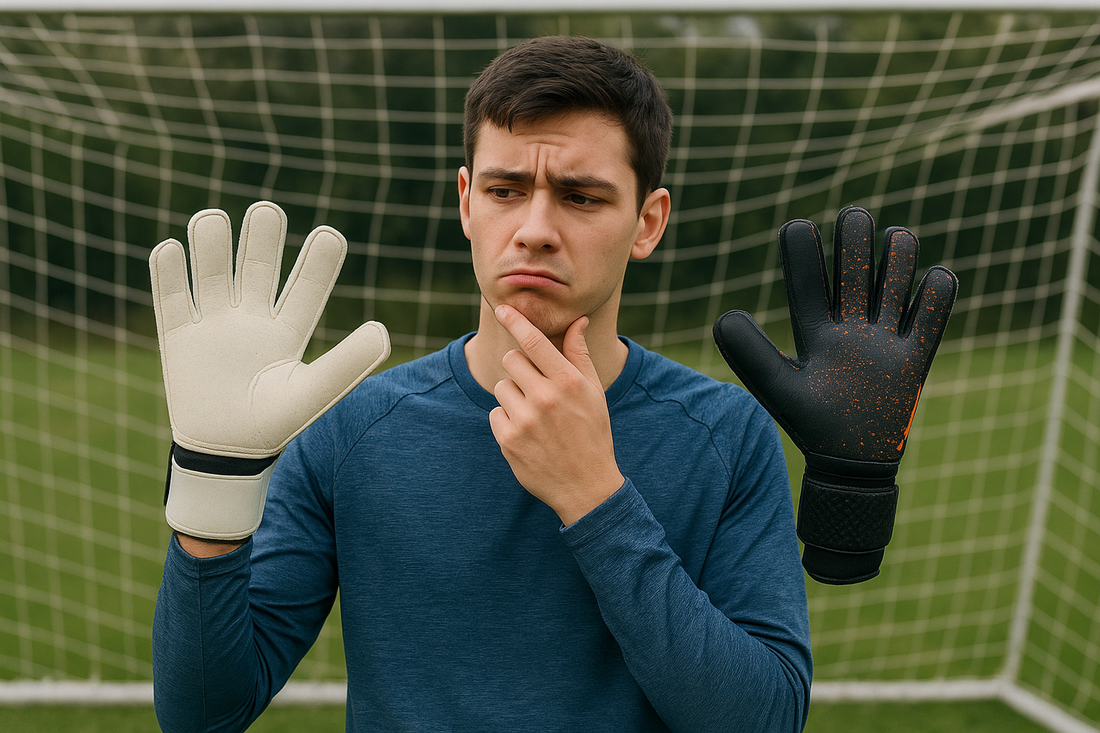
How to choose goalkeeper gloves?
Share
Description of goalkeeper gloves
Goalkeeper gloves are an essential part of a goalkeeper's kit, designed to protect the hands and provide a better grip on the ball. The gloves are designed to provide good feel and control, while also protecting the hands from impacts and blows. They come in different models and designs, depending on the player's needs, skill level and age group.
Structure and function:
Goalkeeper gloves are usually made up of several layers: an outer layer (which protects against abrasion), a middle layer for cushioning and comfort, and an inner layer that is designed to provide a tight and comfortable grip. Most gloves are made with an elastic cuff or Velcro closure to provide a snug fit around the wrist.
How to choose goalkeeper gloves
When choosing goalkeeper gloves, there are several factors to consider, especially for children who need extra protection and comfort. Here are some key points to consider:
-
Size:
The gloves should fit well, neither too big nor too small. For children, it is especially important to find the right size to ensure they get a good feel for the ball and don't lose control. Most manufacturers provide a size guide based on the length of the hand (from the wrist to the tip of the middle finger). -
Grip material (latex):
Latex is the most commonly used material for goalkeeper gloves, and there are several varieties designed for different playing conditions. Latex provides the best grip on the ball, but the quality varies depending on how soft the latex is:-
Soft latex: Provides excellent grip, but has a shorter lifespan, especially on hard surfaces.
-
Hard latex: More durable, but provides a slightly poorer grip, often used on training gloves.
-
-
Weather conditions:
There are goalkeeper gloves adapted to different weather conditions. If your child plays in the rain or on wet pitches, it may be a good idea to choose a glove with a water-repellent coating that will maintain grip even when wet. For dry weather, it is easier to choose a glove with more durability. -
Type of glove (cut):
Goalkeeper gloves come in different cuts, which determine how they are sewn and how they fit on the hand:-
Flat cut: A common and affordable solution that provides plenty of room for the fingers.
-
Negative cut: More snug and comfortable, ideal for players who want a more precise fit.
-
Roll finger: The glove is sewn around the fingers to provide better grip, often used in training.
-
-
Protection and comfort:
For younger players, it may be a good idea to choose goalkeeper gloves with extra protection on the fingers and palm to reduce the risk of injury. Many children's gloves have extra padding and protection around the areas most susceptible to impacts and impacts.
Materials in goalkeeper gloves
-
Latex:
Latex is the most popular material for goalkeeper gloves due to its exceptional grip and feel. Different types of latex have different properties:-
Super Soft Latex: Provides fantastic grip, but wears out quickly, therefore best suited for play in drier conditions.
-
Professional Latex: Balances grip and durability, used by both professional and ambitious players.
-
Training Latex: More durable and often used for training gloves.
-
-
PU (polyurethane):
PU is a synthetic material that provides good durability, but is not as good as latex on wet surfaces. It is often used for training gloves or cheaper models. -
Nylon and mesh:
These materials are used in the insole and on the back of the gloves to provide breathability and better ventilation, preventing your hands from getting too hot or sweaty during intense play. -
Gel and special padding:
For extra protection, some gloves have gel or silicone padding on the fingernails and palm. This provides increased comfort and reduces the risk of injury from hard ball hits.
Babysitter gloves
When choosing goalkeeper gloves for children, it is important to consider comfort, fit and protection. Children's goalkeeper gloves are designed to provide extra support for young players who are still developing their technique. They are often made of materials that can withstand a lot of wear and tear, while still providing a good grip. Most children's gloves have a softer latex, which makes them easier to use for children who may have less strength and control over the ball.
Things to keep in mind for babysitting gloves:
-
Size and fit are especially important, as children grow quickly. Gloves should not be too big, as this can reduce ball control.
-
Protection: Babysitting gloves often have extra protection on the fingers and wrists to prevent injuries.
-
Ease of use: Choose models that are easy for the child to put on and take off, preferably with Velcro or elastic cuffs to make it easier.
Summary
Choosing goalkeeper gloves for children and adults depends on a number of factors, including grip, comfort, protection and choice of material. For children, emphasis should be placed on good fit, protection and durability, while it is important that they can move their hands freely and control the ball. Remember that the quality of the latex and gloves will generally vary, so it is important to adapt the choice to the playing conditions and level.
At incontact.no you will find high-quality gloves in professional quality. Our models for adults and children use the finest latex, which contributes to high performance.
